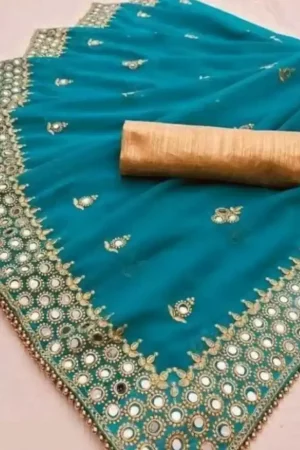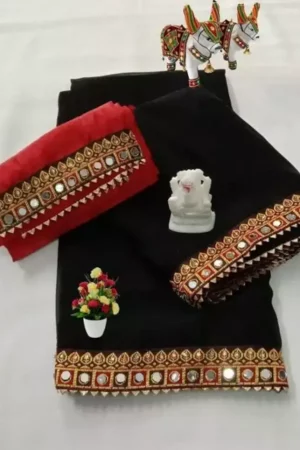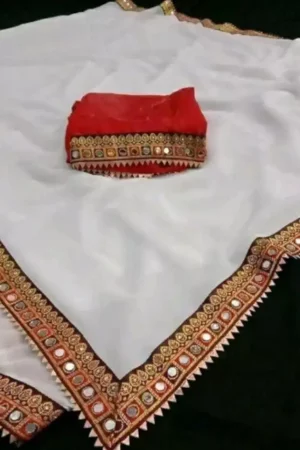Buy Mirror Work Saree Online
-
Product on sale
 Bridal Red Georgette Saree Diamond Mirror WorkOriginal price was: ₹10,599.00.₹1,549.00Current price is: ₹1,549.00.
Bridal Red Georgette Saree Diamond Mirror WorkOriginal price was: ₹10,599.00.₹1,549.00Current price is: ₹1,549.00. -
Product on sale
 Janhvi Kapoor Designer Net Embroidered SareeOriginal price was: ₹7,300.00.₹1,149.00Current price is: ₹1,149.00.
Janhvi Kapoor Designer Net Embroidered SareeOriginal price was: ₹7,300.00.₹1,149.00Current price is: ₹1,149.00. -
Product on sale
 White Green Cotton Saree Blue Motif Mirror WorkOriginal price was: ₹7,886.00.₹1,149.00Current price is: ₹1,149.00.
White Green Cotton Saree Blue Motif Mirror WorkOriginal price was: ₹7,886.00.₹1,149.00Current price is: ₹1,149.00. -
Product on sale
 Blue Georgette Half-Half Saree Stone WorkOriginal price was: ₹1,989.00.₹1,099.00Current price is: ₹1,099.00.
Blue Georgette Half-Half Saree Stone WorkOriginal price was: ₹1,989.00.₹1,099.00Current price is: ₹1,099.00. -
Product on sale
 Buy White Saree Red Mirror Work OnlineOriginal price was: ₹5,899.00.₹1,049.00Current price is: ₹1,049.00.
Buy White Saree Red Mirror Work OnlineOriginal price was: ₹5,899.00.₹1,049.00Current price is: ₹1,049.00. -
Product on sale
 White Silk Satin Saree Mirror Work Red BorderOriginal price was: ₹8,810.00.₹1,149.00Current price is: ₹1,149.00.
White Silk Satin Saree Mirror Work Red BorderOriginal price was: ₹8,810.00.₹1,149.00Current price is: ₹1,149.00. -
Product on sale
 Royal Blue Plain Satin Saree Mirror WorkOriginal price was: ₹6,499.00.₹1,149.00Current price is: ₹1,149.00.
Royal Blue Plain Satin Saree Mirror WorkOriginal price was: ₹6,499.00.₹1,149.00Current price is: ₹1,149.00. -
Product on sale
 Kashmiri Net Silk Flower work & Stone Embellished SareeOriginal price was: ₹6,899.00.₹1,249.00Current price is: ₹1,249.00.
Kashmiri Net Silk Flower work & Stone Embellished SareeOriginal price was: ₹6,899.00.₹1,249.00Current price is: ₹1,249.00. -
Product on sale
 Black Embroidered Georgette SareeOriginal price was: ₹5,450.00.₹1,249.00Current price is: ₹1,249.00.
Black Embroidered Georgette SareeOriginal price was: ₹5,450.00.₹1,249.00Current price is: ₹1,249.00. -
Product on sale
 Blue Georgette Designer Embroidered Silver BorderOriginal price was: ₹8,889.00.₹1,449.00Current price is: ₹1,449.00.
Blue Georgette Designer Embroidered Silver BorderOriginal price was: ₹8,889.00.₹1,449.00Current price is: ₹1,449.00. -
Product on sale
 Green Georgette Saree Floral Mirror Red BorderOriginal price was: ₹9,852.00.₹1,149.00Current price is: ₹1,149.00.
Green Georgette Saree Floral Mirror Red BorderOriginal price was: ₹9,852.00.₹1,149.00Current price is: ₹1,149.00. -
Product on sale
 Pink Georgette Half-Half SareeOriginal price was: ₹5,989.00.₹1,099.00Current price is: ₹1,099.00.
Pink Georgette Half-Half SareeOriginal price was: ₹5,989.00.₹1,099.00Current price is: ₹1,099.00. -
Product on sale
 White Saree Pink Embroidered Mirror WorkOriginal price was: ₹6,810.00.₹1,149.00Current price is: ₹1,149.00.
White Saree Pink Embroidered Mirror WorkOriginal price was: ₹6,810.00.₹1,149.00Current price is: ₹1,149.00. -
Product on sale
 Orange Georgette Saree Golden Embroidered Peach Work BorderOriginal price was: ₹2,810.00.₹789.00Current price is: ₹789.00.
Orange Georgette Saree Golden Embroidered Peach Work BorderOriginal price was: ₹2,810.00.₹789.00Current price is: ₹789.00. -
Product on sale
 Black Georgette Saree Red Floral Mirror Work LaceOriginal price was: ₹8,799.00.₹1,149.00Current price is: ₹1,149.00.
Black Georgette Saree Red Floral Mirror Work LaceOriginal price was: ₹8,799.00.₹1,149.00Current price is: ₹1,149.00. -
Product on sale
 Purple Georgette Saree Golden Mirror WorkOriginal price was: ₹8,979.00.₹1,249.00Current price is: ₹1,249.00.
Purple Georgette Saree Golden Mirror WorkOriginal price was: ₹8,979.00.₹1,249.00Current price is: ₹1,249.00. -
Product on sale
 Yellow Plain Georgette Saree Mirror Work LaceOriginal price was: ₹8,979.00.₹1,049.00Current price is: ₹1,049.00.
Yellow Plain Georgette Saree Mirror Work LaceOriginal price was: ₹8,979.00.₹1,049.00Current price is: ₹1,049.00. -
Product on sale
 Black Georgette Designer Embroidered Silver BorderOriginal price was: ₹8,450.00.₹1,449.00Current price is: ₹1,449.00.
Black Georgette Designer Embroidered Silver BorderOriginal price was: ₹8,450.00.₹1,449.00Current price is: ₹1,449.00. -
Product on sale
 Wine Red Silk Saree Half-Half Floral Embroidered WorkOriginal price was: ₹2,998.00.₹1,259.00Current price is: ₹1,259.00.
Wine Red Silk Saree Half-Half Floral Embroidered WorkOriginal price was: ₹2,998.00.₹1,259.00Current price is: ₹1,259.00. -
Product on sale
 White Cotton Saree Blue Motif Mirror WorkOriginal price was: ₹1,345.00.₹699.00Current price is: ₹699.00.
White Cotton Saree Blue Motif Mirror WorkOriginal price was: ₹1,345.00.₹699.00Current price is: ₹699.00. -
Product on sale
 Yellow Georgette Saree Floral Mirror Red BorderOriginal price was: ₹4,052.00.₹1,049.00Current price is: ₹1,049.00.
Yellow Georgette Saree Floral Mirror Red BorderOriginal price was: ₹4,052.00.₹1,049.00Current price is: ₹1,049.00. -
Product on sale
 Navy Blue Georgette Designer Embroidered Silver BorderOriginal price was: ₹8,998.00.₹1,449.00Current price is: ₹1,449.00.
Navy Blue Georgette Designer Embroidered Silver BorderOriginal price was: ₹8,998.00.₹1,449.00Current price is: ₹1,449.00. -
Product on sale
 Buy Coal Black Georgette Saree Mirror Embroidered Work OnlineOriginal price was: ₹4,689.00.₹899.00Current price is: ₹899.00.
Buy Coal Black Georgette Saree Mirror Embroidered Work OnlineOriginal price was: ₹4,689.00.₹899.00Current price is: ₹899.00. -
Product on sale
 Buy Cyan Blue Georgette Saree Mirror Embroidered Work OnlineOriginal price was: ₹4,689.00.₹899.00Current price is: ₹899.00.
Buy Cyan Blue Georgette Saree Mirror Embroidered Work OnlineOriginal price was: ₹4,689.00.₹899.00Current price is: ₹899.00. -
Product on sale
 Buy Forest Green Georgette Saree Mirror Embroidered Work OnlineOriginal price was: ₹4,689.00.₹899.00Current price is: ₹899.00.
Buy Forest Green Georgette Saree Mirror Embroidered Work OnlineOriginal price was: ₹4,689.00.₹899.00Current price is: ₹899.00. -
Product on sale
 Buy Rani Pink Georgette Saree Mirror Embroidered Work OnlineOriginal price was: ₹4,689.00.₹899.00Current price is: ₹899.00.
Buy Rani Pink Georgette Saree Mirror Embroidered Work OnlineOriginal price was: ₹4,689.00.₹899.00Current price is: ₹899.00. -
Product on sale
 Buy Red Chilli Georgette Saree Mirror Embroidered Work OnlineOriginal price was: ₹4,689.00.₹899.00Current price is: ₹899.00.
Buy Red Chilli Georgette Saree Mirror Embroidered Work OnlineOriginal price was: ₹4,689.00.₹899.00Current price is: ₹899.00. -
Product on sale
 Buy White Georgette Saree Mirror Embroidered Work OnlineOriginal price was: ₹4,689.00.₹899.00Current price is: ₹899.00.
Buy White Georgette Saree Mirror Embroidered Work OnlineOriginal price was: ₹4,689.00.₹899.00Current price is: ₹899.00. -
Product on sale
 Buy Yellow Georgette Saree Mirror Embroidered Work OnlineOriginal price was: ₹4,689.00.₹899.00Current price is: ₹899.00.
Buy Yellow Georgette Saree Mirror Embroidered Work OnlineOriginal price was: ₹4,689.00.₹899.00Current price is: ₹899.00. -
Product on sale
 Grey Georgette Saree Mirror Work Silver BorderOriginal price was: ₹8,209.00.₹1,589.00Current price is: ₹1,589.00.
Grey Georgette Saree Mirror Work Silver BorderOriginal price was: ₹8,209.00.₹1,589.00Current price is: ₹1,589.00. -
Product on sale
 Blue Plain Georgette Saree Mirror Work LaceOriginal price was: ₹5,679.00.₹1,099.00Current price is: ₹1,099.00.
Blue Plain Georgette Saree Mirror Work LaceOriginal price was: ₹5,679.00.₹1,099.00Current price is: ₹1,099.00. -
Product on sale
 Buy Red Net Saree Floral Diamond Embroidered Work OnlineOriginal price was: ₹8,869.00.₹1,669.00Current price is: ₹1,669.00.
Buy Red Net Saree Floral Diamond Embroidered Work OnlineOriginal price was: ₹8,869.00.₹1,669.00Current price is: ₹1,669.00. -
Product on sale
 Buy Red Net Saree Floral Diamond Embroidered Border OnlineOriginal price was: ₹12,789.00.₹2,200.00Current price is: ₹2,200.00.
Buy Red Net Saree Floral Diamond Embroidered Border OnlineOriginal price was: ₹12,789.00.₹2,200.00Current price is: ₹2,200.00. -
Product on sale
 Buy Black Net Saree Floral Gold Embroidered Border OnlineOriginal price was: ₹8,499.00.₹1,569.00Current price is: ₹1,569.00.
Buy Black Net Saree Floral Gold Embroidered Border OnlineOriginal price was: ₹8,499.00.₹1,569.00Current price is: ₹1,569.00.
The Timeless Elegance of Mirror Work Sarees: A Blend of Heritage and Modernity
Introduction to mirror work in saree
Mirror work, also known as sheesha and abhala Bharat embroidery has evolved into a timeless art form, gracing the fabric of sarees and becoming a cherished element in modern wardrobes. Renowned artisans and designers specializing in mirror work share insights into the history and modernization of this craft, particularly its integration into the world of saree fashion.
Origin of Mirror work saree and Journey to India
The origins of mirror work are trackable back to 13th-century Persia, making its way to India during the Mughal era. Rooted in traditional Islamic beliefs, mirrors possess protective qualities against evil spirits and bad luck. The craft flourished in India, gaining prominence in the 17th century with the migration of the Jat community from Balochistan, bringing along traditional Balochi mirror work techniques. Today, Rajasthan, Gujarat, and Haryana stand as hubs for this ancient craft, especially in the context of saree craftsmanship.
Mirror Work in Contemporary Saree Fashion
Artisans and designers, celebrated for their expertise in mirror work, have seamlessly integrated this art form into the world of sarees. Mirror work has become a signature element in their collections, adorning sarees with deconstructed motifs, gota and silk threads, prints, and modern silhouettes. This fusion of mirror work with traditional saree fashion creates unique and recognizable brands and captivates saree enthusiasts.
Artisan Collaboration and Inspiration
Collaborative efforts with 10-12 artisans, frequently travelling to saree-centric regions like Rajasthan, Lucknow, and Hyderabad, inspire these artisans and designers in the realm of saree creation. Infused with architectural elements, the sarees feature classic and vintage designs, telling a captivating story through the heirloom quality of mirror work. This collaboration solidifies mirror work as an integral part of contemporary saree collections.
Innovation and Future Outlook for Mirror Work Sarees
Constantly challenging themselves, artisans and designers are at the forefront of innovating with mirror work in sarees. Their experimentation with fabrics, colours, and silhouettes envisions a future where mirror work sarees continue to thrive through modern designs. By giving this age-old handcraft a contemporary outlook within the saree landscape, they ensure its enduring relevance for generations to come.
How did mirror work find its way into Indian saree fashion?
Mirror work in sarees originated in 13th-century Persia and arrived in India during the Mughal era, gaining prominence in the 17th century with the migration of the Jat community from Balochistan.
How do artisans and designers incorporate mirror work into sarees?
Mirror work is a signature element in their saree collections, featuring deconstructed motifs, gota and silk threads, prints, and modern silhouettes, contributing to a unique saree identity.
What is the future of mirror work in the realm of saree fashion?
Artisans and designers envision a vibrant future for mirror work sarees, foreseeing constant innovation that blends tradition with contemporary designs, appealing to the younger generation of mirror work saree enthusiasts.
What are the different types of mirror work sarees?
Mirror work sarees, with their captivating shimmer and intricate designs, have adorned Indian women for centuries. But this stunning attire exists in a vibrant tapestry of variations, each boasting unique charm and cultural significance. Let’s delve into the fascinating world of mirror work saree types:
Kutchi Mirror Work: Hailing from the arid beauty of Kutch, Gujarat, these sarees are renowned for their intricate geometric patterns. Tiny mirrors, often arranged in triangles, squares, and diamonds, form mesmerizing kaleidoscopes.
Rajasthani Mirror Work: Vibrant and opulent, Rajasthani mirror work sarees are a riot of colour. Bold floral motifs, paisley designs, and intricate borders with mirror embellishments create a regal ensemble.
Sindhi Mirror Work: Characterized by bold geometric patterns and vibrant threadwork, Sindhi mirror work sarees exude a rustic charm. Large, round mirrors often take centre stage, creating a striking contrast against the fabric’s vivid hues.
Phulkari Mirror Work: Originating from Punjab, Phulkari mirror work sarees showcase intricate floral embroidery alongside delicately placed mirrors. The result is a delicate and feminine ensemble, perfect for festive occasions.
Leheriya Mirror Work: This unique style from Rajasthan combines the mesmerizing tie-dye effect of leheriya fabric with subtle mirror embellishments. The result is a breathtaking interplay of colour and light, with the mirrors catching the eye amidst the swirling hues.
While regional styles hold a special place, mirror work sarees have transcended boundaries, embracing contemporary twists and diverse fabrics. Embellished chiffons, georgettes, and even silks offer modern takes on the classic, catering to a broader range of tastes and occasions.
So, whether one gets drawn to the intricate geometry of Kutchi work, the vibrant charm of Rajasthani motifs, or the delicate elegance of Phulkari designs, there’s a mirror work saree waiting to add its sparkle to everyone’s life. Let this dazzling tapestry guide people on their journey to discover their perfect pieces to reflect their unique style and grace.
